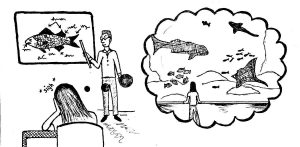Remember the excitement you felt as you prepared to depart on a class field trip, free of the normal rules and work that school presented? I never truly appreciated those outings until I got to Redwood, where until a few months ago the farthest I ever traveled off campus with a class was across the street.
The number of field trips occurring in schools nationwide has been declining steadily for the past several years, and Redwood is no exception. The educational value of such trips is perceived to be outweighed by the money and effort required organize them.

Having been a student of a small private elementary and middle school, I have fond memories of piling into yellow busses with my classmates several times per year, off to a nearby art museum or historic site. We also took the occasional three or four-day-long trip to a place like Coloma or San Diego, where we learned about the Gold Rush or marine biology.
Many schools would rather focus time and funding on equipment or on preparing students for exams. But after weeks of tiring, repetitive seven-hour days, students and teachers alike would benefit from a getting out of the classroom—and I don’t mean letting students work out in the quad, although on a nice day we welcome the change of scenery.
Earlier this year, I and other AP Spanish students had the opportunity to participate in the annual outing to Mi Pueblo, a Mexican grocery store located in San Rafael.
Because volunteer student and parent drivers provided transportation and getting into a grocery store doesn’t cost anything, the trip was very inexpensive. Students could use their own money to buy a snack if they desired, but the only thing that was required was a guardian’s signature.
The excursion took place within a block period, so students didn’t have to miss any other classes or use any of their free time outside of school.
We learned about Mexican food and culture, practiced our Spanish in a real-world setting, bonded with our classmates and enjoyed a short break from traditional schoolwork. What’s not to love?
One of the reasons many teachers refuse to go on field trips is simply because they are too hard to organize. It takes hours of work from teachers and members of the school administration alike to make a trip happen.
In past years, the AP Environmental Science classes have taken a tour of the Marin Municipal Water District treatment plant in Corte Madera. This year, the trip was canceled and a speaker from the water district was instead brought in to give the class a presentation.
Because of the difficulty of organizing field trips, teachers are more and more often choosing to find alternatives, even if the field trip has been held annually for years.
Perhaps rethinking the process of getting field trips approved would increase their popularity with the faculty and staff.
I admit that a class taking a week-long international trip might not be feasible. Traveling can be expensive and can require students to miss too much school. God forbid we turn in a project a little late.
But shorter, local trips would enrich our learning experience and give us something to look forward to.
For students, field trips offer a chance to connect what we learned in class to a real-life experience. Outside of the lab sciences, we don’t often get to engage in interactive learning activities, which studies show are more effective.
The physical, visual and social aspects of field trips make them more enticing to students than the usual lecture or textbook reading. Attaching information to a memorable place or activity can help us retain it better. According to a study done by Columbia University, having a visual aid increases the retention of information by up to 38 percent.
Field trips also allow us to explore future career paths and expose us to art, culture, and history. In addition, these excursions present something often overlooked in an academic setting: fun.
Some might argue that students should make these outings on their own time. Teachers often adopt this mindset as well, giving incentives to attend certain events or exhibits outside of school by offering points for proof of attendance.
But many of us have limited free time, and by going alone, we miss out on most of the academic benefits that come with going with a class. Without a teacher, questions can go unanswered and certain concepts left unexplained. We would also lack the focus and learning-oriented mindset that a school-related environment provides.
So please, take us to a science museum, or a play, or a historical exhibit. There is no shortage of interesting places in the Bay Area.
As a school that values the experiences and academic success of its students, Redwood should be more open to letting us learn outside the classroom.






